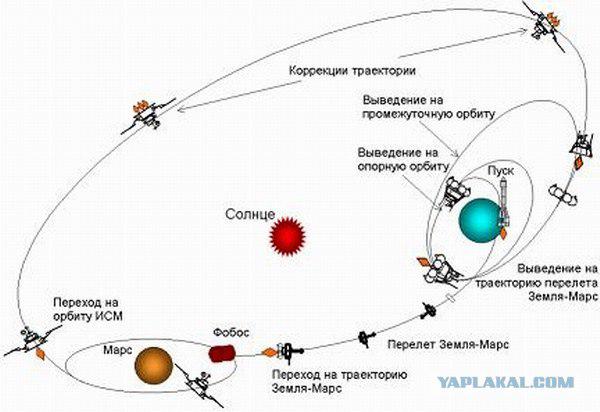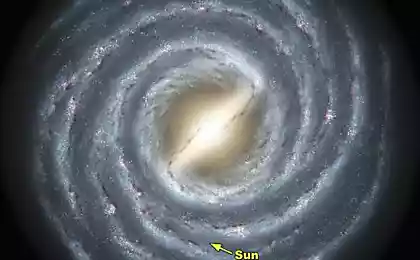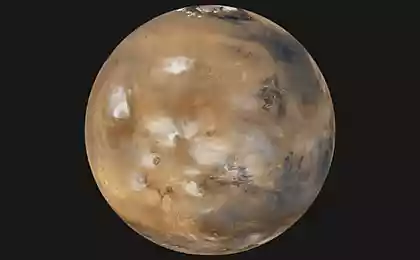797
Mysterious Island Solar System
Although on the surface of Phobos rises his lone monolith, the satellite itself, apparently, is not a monolith
In the history of research bodies of the solar system by means of automatic space stations for each planet - has its own page. Despite the proximity of the mysterious moons of Mars - Phobos and Deimos - Mars to himself, it is not always possible to include in the one mission tasks associated with the first and the second and the third. The ambitious Russian program for the delivery to the Earth samples of soil from the Martian satellite has more than twenty years. Now it is threatened by a new delay.
Unsteady body
Recall that Phobos and Deimos, the smaller size were opened simultaneously in 1877 by American astronomer Asaph Hall (Asaph Hall III, 1829-1907), then at the Naval Observatory in Washington, DC (US Naval Observatory). However, the existence of the two satellites of Mars has said Johannes Kepler (Johannes Kepler, 1571-1630), to substantiate his hypothesis reasoning that today no scientist has agreed to recognize as legitimate. He believed that everything in the cosmos is subject to strict laws of harmony - both musical and geometric, - he described in his treatise "cosmographical mystery» (Mysterium cosmographicum, 1596) and "Harmony of the World» (Harmonices mundi, 1619). The presence of one satellite of the Earth and four of Jupiter meant that, in his view, the satellites are distributed over the planets of the solar system in powers of two: 20 = 1, 21 = 2, 22 = 4, ..., - thereby forming a geometric progression. Her second term corresponded to Mars. It is unlikely that it would be worth mentioning, if for almost half a century before the opening of the Hall "scientific conclusion" Kepler is not immortalized author of "Gulliver's Travels" by Jonathan Swift (Jonathan Swift, 1667-1745). Describing his trip to the floating island of Laputa, Gulliver tells Laputan astronomer who discovered the two moons of Mars ...
Scene from the movie "Phobos. Club of fear "(2009). Since its opening, the mysterious companion of Mars inspired people to unpleasant associations. It is no coincidence the name: "Phobos" in Greek means "fear". Photo: Art pictures studio

Because of their small size (Phobos, for example, is an irregularly shaped rock less than 28 km in diameter) satellite for a long time did not attract the attention of astronomers. Even after the opening of the Hall for a long time attributed to the category of space rocks that were too close to Mars and captured by its gravitational field. And Phobos and Deimos' surface is covered with craters, but these craters on Phobos - deep parallel furrows depth of 10 to 20 m (some reach a length of 30 km) - quite a lot; Deimos similar to the missing band and craters significantly smaller. Herein lies one of the mysteries of the moons of Mars: why is quite smooth surface of Deimos and Phobos - cratered?
However, this did not end the puzzle. In the orbit of Phobos is quite strange parameters indicating too small for the size of the mass. Abnormally small density of the satellite became the basis for the hypothesis of the Soviet astrophysicist Iosif Shklovsky (1916-1985) of the artificial origin of the Martian satellite. Their thoughts on this Shklovsky unveiled in 1958 - after just a year after the start of the first Soviet satellite. Shklovsky, one of the most active promoters of the idea of cosmic panspermia and the search for extraterrestrial intelligence, believed that Phobos is a hollow metal sphere with a diameter of 16 km and about 6 cm thick. Two years later, Fred Singer (Fred Singer), science advisor of US President Dwight D. Eisenhower (Dwight David Eisenhower, 1890-1969), published a letter in the journal «Astronautics»:
Phobos task - to protect the planet from radiation, allowing the Martians avoid dangers when working in orbit. ... I support the hypothesis Shklovsky ... Based on the astronomical observations, it is unlikely there will be other explanations for them, except for man-made satellite. ... Another thing is that in the observations themselves may be a bug.
In the end it turned out just the second. New astronomical data buried the idea of an artificial origin of the satellite. Perceptions of Phobos changed dramatically after the appearance of the data on the spectral composition of light reflected from its surface. This information has been obtained with spectrographs US probe "Mariner 9", launched in 1971, and Russian "Phobos-2", launched in 1988. It was found that the surface of Phobos absorbs more than 90 percent of the incident solar radiation, indicating its similarity to the type of carbonaceous chondrite asteroids from the outer asteroid belt, located twice as far from the Sun than Mars itself.
All in a satellite of Mars unusual and mysterious: the size and shape, and low density. In 50 years on both sides of the Atlantic have been proponents of its artificial origin. Photo: ESA

The problem, however, is that the hypothesis of the origin of the asteroid satellites of Mars is hardly consistent with the parameters of the orbit in which these satellites move. If satellites were indeed asteroids, which were captured by the gravitational field of Mars, their orbits would be oriented in space in various ways. In fact, the plane of the orbit and of Phobos and Deimos are almost identical with the equatorial plane of Mars. This fact is used as the argument of its supporters another hypothesis, according to which the moons of Mars were formed from the same protoplanetary cloud from which he emerged Mars. In this case, the substance of which consist Phobos and Deimos, should be similar to those craggy rocks that make up Mars. To bring clarity to this issue, which is currently in a Mars orbit, the European probe «Mars Express» has carried out a series of successive spans of Phobos come close to the surface to 460 km in 2006 and 270 km - in 2008. The full talk about the results of these flown so far, but some conclusions can already be done.
One of the main characteristics of Phobos is its extremely low density. Currently, it is estimated at 1 887 g / cm3 (albeit from a hollow metal sphere, it should be even less). This strange fact is explained by the presence of a normally satellite large deposits of ice or porosity of its structure. In May this year in the annex to the journal Geophysical «Geophysical Research» («Geophysical Research Letters») published the results of a recent study conducted at the University of the German Armed Forces in Munich (Universität der Bundeswehr München). The authors argue that the body of the satellite is not just porous - there is at least 30% voids - but most likely simply connected. They are calling to abandon the idea of him as a solid. In this regard, landing on its surface can be problematic.
Russian trace on soft rocks
For the Russian space exploration program automatic stations the next few years will be very important - the end of 2011 is scheduled to launch a Russian automatic station "Phobos - Grunt". According to the original plan of the Russian probe was supposed to go to Phobos in 2010 (launch window is October), but the launch has been postponed in order to improve the reliability of the project. Before the station set very ambitious goals: it should make a soft landing on the Martian moon Phobos, to take soil samples and then return the samples back to Earth.
The idea is not new. More than two decades ago, in July 1988, on the flight path to Mars were withdrawn just two automatic interplanetary station - "Phobos-1" and "Fobos-2". The first of these devices was lost a month after the start because of failures in the control system, while the second came safely to Mars orbit. It was assumed that the "Phobos-2" comes closer to the Martian satellites and "drop off" on its surface landers. However, this problem could not be realized. Due to problems in the control system communication has been lost and the second station. Despite the failure of the main task of the mission "Phobos-2" managed to pass the Earth is extremely valuable information - in particular, to find out the thermal characteristics of Phobos and details of the Martian atmosphere interaction with the solar wind.
The lander project "Phobos - Grunt". A life-size model. Photo: CNES

It was planned that the return on Phobos will not be long in coming. Everything was ready for this. But prevented the political factor: the call for the Academy to focus on "breakthrough areas" in the 90s turned to "freeze" the program indefinitely. The direction toward Mars was "neproryvnym"! Only in the early 2000s, it was decided to organize a new expedition to Phobos.
As follows from the title of the project, its main task - delivery to the Earth samples of soil from Phobos. The Space Station will have to go into orbit around Mars, then it separates from the descent module that will land on the surface of Phobos. Return the unit to soil samples, using special mechanical tappets (not to damage the rest of Phobos scientific equipment), rises above the surface of the Martian satellites at a safe height, then turn on the propulsion system and the unit will go into orbit around Mars. Then the machine will have to go to okolomarisanskoy orbit to the trajectory of the Earth, and after about an eleven-month mission to land on the planet. In an interview with "Nezavisimaya Gazeta" one of the main authors of the project, member of the Russian Academy of Sciences Erik Galimov, said: "If we do that, then we immediately become equal participants in the Martian club: in our hands - that is very important - the substance, which no one else no". At the same time using the remaining devices on the surface of Phobos surface studies will be continued; Special arm will grab samples of the soil near the lander and deliver them to the devices - mini-cameras and spectrometers.
But why such a large scale as an objective and expensive flight to Mars was not chosen himself Mars, but his companion? The reasons for such a choice few. First of all, landing on Phobos will cost much cheaper than the landing on Mars. Moreover, such an operation may be even cheaper than a similar expedition to the Moon. The fact is that Phobos has an extremely low weight - just two billionths of Earth's mass - and therefore extremely weak gravitational field. This means that the landing on its surface, and after start back require a very small amount of fuel. Accordingly, a lower starting weight and the station during its launch from Earth.
The development of the project "Phobos - Grunt" attended by several large Russian companies. Devices are NPO. Lavochkin, ballistics calculations conducted by the Institute of Applied Mathematics. Keldysh. Illustration: IPM them. Keldysh

Return to Mars
This advantage is evident not only in Russia. In the United States, where, after joining the White House new administration's plans for a large-scale reimposition of space research, is also growing interest in the study of Phobos. In October 2009, it was created by a committee of independent experts, headed by industrialist Norman Augustine (Norman Augustine). The report offers a NASA committee to organize an expedition to nearby asteroids and to the moons of Mars. English magazine «New Scientist» leads in connection with the President's comments the California Institute of Mars (Mars Institute) Pascal Lee (Pascal Lee), which, inter alia, said: "Phobos - a step, climbing on which we will be very close to the to Mars ».
Of course, this steps we can learn a lot about Mars unusually. But it would be a serious mistake to take the flight to Phobos exclusively in the context of the research program of the red planet. The fact is that Phobos and of itself is a giant cosmic puzzle. Pascal Lee explained it this way: "We are more or less imagine the nature of all the objects in the solar system that we studied - all except Phobos ... We still do not know how it was formed».
Lacking real Phobos soil samples, we can only indulge in fantasies with regard to its chemical composition, and therefore - and its origin. If Phobos is an asteroid captured by Mars' gravity, the density of the material from which it is to be slightly less dense than ordinary rocks - in this case, the void will have about 15 percent of its volume. If it consists of substances that are more reminiscent of the rugged rocks of Mars, the Martian satellite voids may be substantially more - up to 45 percent of the total.
If indeed it turns out that Phobos is of Martian rocks, the presence of a such a large void will make us give up the scenario in which the Martian moon was formed of tiny particles of dust got into orbit during the formation of Mars. Quite possibly, the satellite was formed when a giant impact on Mars has led to the ejection of debris in orbit of the planet.
It is this hypothesis tested recently «Mars Express». March 3, 2010 the European probe close to the surface of Phobos at a distance of 67 km. It is estimated that with this approximation of its trajectory had to be quite sensitive to inhomogeneities of a gravitational field of Phobos, which in the end will allow to identify and void volume - the results of measurements is handled.
But if the question of the voids in the thickness of the Martian satellite can, at least partly, be clarified with the help of probes such as the station «Mars Express», the question of what is the surface of Phobos, one can find out only after its delivery to the Earth samples. In figurative remark Lee, "Phobos Mars performs the role of the Library of Alexandria." Namely: "It is possible that the rock samples on Phobos Martian young survived better than the Mars. It is possible that these samples contained chemical traces of life on Mars ».
Yet there is a mysterious Phobos Monolith (Monolith) - extending 90 meters into space one-piece solid rocky ledge, knocking on the surface of Phobos giant shadow. Lee calls it fobosovskim "Empire State Building". And in a research program of automatic stations which, we hope, will go to Phobos in the near future, certainly will study the soil near the mysterious skyscraper on the surface of the Martian satellite. So, it is in the vicinity of the Monolith was due to land unit of the Canadian Space Agency (Canadian Space Agency) in accordance with the project PRIME (Phobos Reconnaissance and International Mars Exploration). However, at the present time and this project is frozen
But appeals to defrost frozen in the 90s are heard louder projects on both sides of the Atlantic. Journalists from «New Scientist» calling their buddies scientists to look into the more distant future in which people will go to Phobos. As the correspondent of the magazine staff member's Jet Propulsion Laboratory (NASA Jet Propulsion Laboratory) in Pasadena Scott Maxwell (one of the drivers of the Mars rovers Spirit and Opportunity), a significant part of the problems with the management of rovers can be removed, if the control of the operators place on Phobos - in this case their team would reach Mars rovers for a hundredth of a second. Needless to say, so it might be fast enough to choose the perfect place to land future spacecraft. It is an optimistic note to her to finish the story about the current state of research of one of the Martian moons.
Boris Bulyubash, 26.05.2010
www.vokrugsveta.ru/telegraph/cosmos/1167
Lonely tridtsatietazhnym skyscraper rises above the surface of Phobos its monolith. Its origins are as mysterious as everything else here. Photo: USGS

Source:
In the history of research bodies of the solar system by means of automatic space stations for each planet - has its own page. Despite the proximity of the mysterious moons of Mars - Phobos and Deimos - Mars to himself, it is not always possible to include in the one mission tasks associated with the first and the second and the third. The ambitious Russian program for the delivery to the Earth samples of soil from the Martian satellite has more than twenty years. Now it is threatened by a new delay.
Unsteady body
Recall that Phobos and Deimos, the smaller size were opened simultaneously in 1877 by American astronomer Asaph Hall (Asaph Hall III, 1829-1907), then at the Naval Observatory in Washington, DC (US Naval Observatory). However, the existence of the two satellites of Mars has said Johannes Kepler (Johannes Kepler, 1571-1630), to substantiate his hypothesis reasoning that today no scientist has agreed to recognize as legitimate. He believed that everything in the cosmos is subject to strict laws of harmony - both musical and geometric, - he described in his treatise "cosmographical mystery» (Mysterium cosmographicum, 1596) and "Harmony of the World» (Harmonices mundi, 1619). The presence of one satellite of the Earth and four of Jupiter meant that, in his view, the satellites are distributed over the planets of the solar system in powers of two: 20 = 1, 21 = 2, 22 = 4, ..., - thereby forming a geometric progression. Her second term corresponded to Mars. It is unlikely that it would be worth mentioning, if for almost half a century before the opening of the Hall "scientific conclusion" Kepler is not immortalized author of "Gulliver's Travels" by Jonathan Swift (Jonathan Swift, 1667-1745). Describing his trip to the floating island of Laputa, Gulliver tells Laputan astronomer who discovered the two moons of Mars ...
Scene from the movie "Phobos. Club of fear "(2009). Since its opening, the mysterious companion of Mars inspired people to unpleasant associations. It is no coincidence the name: "Phobos" in Greek means "fear". Photo: Art pictures studio

Because of their small size (Phobos, for example, is an irregularly shaped rock less than 28 km in diameter) satellite for a long time did not attract the attention of astronomers. Even after the opening of the Hall for a long time attributed to the category of space rocks that were too close to Mars and captured by its gravitational field. And Phobos and Deimos' surface is covered with craters, but these craters on Phobos - deep parallel furrows depth of 10 to 20 m (some reach a length of 30 km) - quite a lot; Deimos similar to the missing band and craters significantly smaller. Herein lies one of the mysteries of the moons of Mars: why is quite smooth surface of Deimos and Phobos - cratered?
However, this did not end the puzzle. In the orbit of Phobos is quite strange parameters indicating too small for the size of the mass. Abnormally small density of the satellite became the basis for the hypothesis of the Soviet astrophysicist Iosif Shklovsky (1916-1985) of the artificial origin of the Martian satellite. Their thoughts on this Shklovsky unveiled in 1958 - after just a year after the start of the first Soviet satellite. Shklovsky, one of the most active promoters of the idea of cosmic panspermia and the search for extraterrestrial intelligence, believed that Phobos is a hollow metal sphere with a diameter of 16 km and about 6 cm thick. Two years later, Fred Singer (Fred Singer), science advisor of US President Dwight D. Eisenhower (Dwight David Eisenhower, 1890-1969), published a letter in the journal «Astronautics»:
Phobos task - to protect the planet from radiation, allowing the Martians avoid dangers when working in orbit. ... I support the hypothesis Shklovsky ... Based on the astronomical observations, it is unlikely there will be other explanations for them, except for man-made satellite. ... Another thing is that in the observations themselves may be a bug.
In the end it turned out just the second. New astronomical data buried the idea of an artificial origin of the satellite. Perceptions of Phobos changed dramatically after the appearance of the data on the spectral composition of light reflected from its surface. This information has been obtained with spectrographs US probe "Mariner 9", launched in 1971, and Russian "Phobos-2", launched in 1988. It was found that the surface of Phobos absorbs more than 90 percent of the incident solar radiation, indicating its similarity to the type of carbonaceous chondrite asteroids from the outer asteroid belt, located twice as far from the Sun than Mars itself.
All in a satellite of Mars unusual and mysterious: the size and shape, and low density. In 50 years on both sides of the Atlantic have been proponents of its artificial origin. Photo: ESA

The problem, however, is that the hypothesis of the origin of the asteroid satellites of Mars is hardly consistent with the parameters of the orbit in which these satellites move. If satellites were indeed asteroids, which were captured by the gravitational field of Mars, their orbits would be oriented in space in various ways. In fact, the plane of the orbit and of Phobos and Deimos are almost identical with the equatorial plane of Mars. This fact is used as the argument of its supporters another hypothesis, according to which the moons of Mars were formed from the same protoplanetary cloud from which he emerged Mars. In this case, the substance of which consist Phobos and Deimos, should be similar to those craggy rocks that make up Mars. To bring clarity to this issue, which is currently in a Mars orbit, the European probe «Mars Express» has carried out a series of successive spans of Phobos come close to the surface to 460 km in 2006 and 270 km - in 2008. The full talk about the results of these flown so far, but some conclusions can already be done.
One of the main characteristics of Phobos is its extremely low density. Currently, it is estimated at 1 887 g / cm3 (albeit from a hollow metal sphere, it should be even less). This strange fact is explained by the presence of a normally satellite large deposits of ice or porosity of its structure. In May this year in the annex to the journal Geophysical «Geophysical Research» («Geophysical Research Letters») published the results of a recent study conducted at the University of the German Armed Forces in Munich (Universität der Bundeswehr München). The authors argue that the body of the satellite is not just porous - there is at least 30% voids - but most likely simply connected. They are calling to abandon the idea of him as a solid. In this regard, landing on its surface can be problematic.
Russian trace on soft rocks
For the Russian space exploration program automatic stations the next few years will be very important - the end of 2011 is scheduled to launch a Russian automatic station "Phobos - Grunt". According to the original plan of the Russian probe was supposed to go to Phobos in 2010 (launch window is October), but the launch has been postponed in order to improve the reliability of the project. Before the station set very ambitious goals: it should make a soft landing on the Martian moon Phobos, to take soil samples and then return the samples back to Earth.
The idea is not new. More than two decades ago, in July 1988, on the flight path to Mars were withdrawn just two automatic interplanetary station - "Phobos-1" and "Fobos-2". The first of these devices was lost a month after the start because of failures in the control system, while the second came safely to Mars orbit. It was assumed that the "Phobos-2" comes closer to the Martian satellites and "drop off" on its surface landers. However, this problem could not be realized. Due to problems in the control system communication has been lost and the second station. Despite the failure of the main task of the mission "Phobos-2" managed to pass the Earth is extremely valuable information - in particular, to find out the thermal characteristics of Phobos and details of the Martian atmosphere interaction with the solar wind.
The lander project "Phobos - Grunt". A life-size model. Photo: CNES

It was planned that the return on Phobos will not be long in coming. Everything was ready for this. But prevented the political factor: the call for the Academy to focus on "breakthrough areas" in the 90s turned to "freeze" the program indefinitely. The direction toward Mars was "neproryvnym"! Only in the early 2000s, it was decided to organize a new expedition to Phobos.
As follows from the title of the project, its main task - delivery to the Earth samples of soil from Phobos. The Space Station will have to go into orbit around Mars, then it separates from the descent module that will land on the surface of Phobos. Return the unit to soil samples, using special mechanical tappets (not to damage the rest of Phobos scientific equipment), rises above the surface of the Martian satellites at a safe height, then turn on the propulsion system and the unit will go into orbit around Mars. Then the machine will have to go to okolomarisanskoy orbit to the trajectory of the Earth, and after about an eleven-month mission to land on the planet. In an interview with "Nezavisimaya Gazeta" one of the main authors of the project, member of the Russian Academy of Sciences Erik Galimov, said: "If we do that, then we immediately become equal participants in the Martian club: in our hands - that is very important - the substance, which no one else no". At the same time using the remaining devices on the surface of Phobos surface studies will be continued; Special arm will grab samples of the soil near the lander and deliver them to the devices - mini-cameras and spectrometers.
But why such a large scale as an objective and expensive flight to Mars was not chosen himself Mars, but his companion? The reasons for such a choice few. First of all, landing on Phobos will cost much cheaper than the landing on Mars. Moreover, such an operation may be even cheaper than a similar expedition to the Moon. The fact is that Phobos has an extremely low weight - just two billionths of Earth's mass - and therefore extremely weak gravitational field. This means that the landing on its surface, and after start back require a very small amount of fuel. Accordingly, a lower starting weight and the station during its launch from Earth.
The development of the project "Phobos - Grunt" attended by several large Russian companies. Devices are NPO. Lavochkin, ballistics calculations conducted by the Institute of Applied Mathematics. Keldysh. Illustration: IPM them. Keldysh

Return to Mars
This advantage is evident not only in Russia. In the United States, where, after joining the White House new administration's plans for a large-scale reimposition of space research, is also growing interest in the study of Phobos. In October 2009, it was created by a committee of independent experts, headed by industrialist Norman Augustine (Norman Augustine). The report offers a NASA committee to organize an expedition to nearby asteroids and to the moons of Mars. English magazine «New Scientist» leads in connection with the President's comments the California Institute of Mars (Mars Institute) Pascal Lee (Pascal Lee), which, inter alia, said: "Phobos - a step, climbing on which we will be very close to the to Mars ».
Of course, this steps we can learn a lot about Mars unusually. But it would be a serious mistake to take the flight to Phobos exclusively in the context of the research program of the red planet. The fact is that Phobos and of itself is a giant cosmic puzzle. Pascal Lee explained it this way: "We are more or less imagine the nature of all the objects in the solar system that we studied - all except Phobos ... We still do not know how it was formed».
Lacking real Phobos soil samples, we can only indulge in fantasies with regard to its chemical composition, and therefore - and its origin. If Phobos is an asteroid captured by Mars' gravity, the density of the material from which it is to be slightly less dense than ordinary rocks - in this case, the void will have about 15 percent of its volume. If it consists of substances that are more reminiscent of the rugged rocks of Mars, the Martian satellite voids may be substantially more - up to 45 percent of the total.
If indeed it turns out that Phobos is of Martian rocks, the presence of a such a large void will make us give up the scenario in which the Martian moon was formed of tiny particles of dust got into orbit during the formation of Mars. Quite possibly, the satellite was formed when a giant impact on Mars has led to the ejection of debris in orbit of the planet.
It is this hypothesis tested recently «Mars Express». March 3, 2010 the European probe close to the surface of Phobos at a distance of 67 km. It is estimated that with this approximation of its trajectory had to be quite sensitive to inhomogeneities of a gravitational field of Phobos, which in the end will allow to identify and void volume - the results of measurements is handled.
But if the question of the voids in the thickness of the Martian satellite can, at least partly, be clarified with the help of probes such as the station «Mars Express», the question of what is the surface of Phobos, one can find out only after its delivery to the Earth samples. In figurative remark Lee, "Phobos Mars performs the role of the Library of Alexandria." Namely: "It is possible that the rock samples on Phobos Martian young survived better than the Mars. It is possible that these samples contained chemical traces of life on Mars ».
Yet there is a mysterious Phobos Monolith (Monolith) - extending 90 meters into space one-piece solid rocky ledge, knocking on the surface of Phobos giant shadow. Lee calls it fobosovskim "Empire State Building". And in a research program of automatic stations which, we hope, will go to Phobos in the near future, certainly will study the soil near the mysterious skyscraper on the surface of the Martian satellite. So, it is in the vicinity of the Monolith was due to land unit of the Canadian Space Agency (Canadian Space Agency) in accordance with the project PRIME (Phobos Reconnaissance and International Mars Exploration). However, at the present time and this project is frozen
But appeals to defrost frozen in the 90s are heard louder projects on both sides of the Atlantic. Journalists from «New Scientist» calling their buddies scientists to look into the more distant future in which people will go to Phobos. As the correspondent of the magazine staff member's Jet Propulsion Laboratory (NASA Jet Propulsion Laboratory) in Pasadena Scott Maxwell (one of the drivers of the Mars rovers Spirit and Opportunity), a significant part of the problems with the management of rovers can be removed, if the control of the operators place on Phobos - in this case their team would reach Mars rovers for a hundredth of a second. Needless to say, so it might be fast enough to choose the perfect place to land future spacecraft. It is an optimistic note to her to finish the story about the current state of research of one of the Martian moons.
Boris Bulyubash, 26.05.2010
www.vokrugsveta.ru/telegraph/cosmos/1167
Lonely tridtsatietazhnym skyscraper rises above the surface of Phobos its monolith. Its origins are as mysterious as everything else here. Photo: USGS

Source:
























